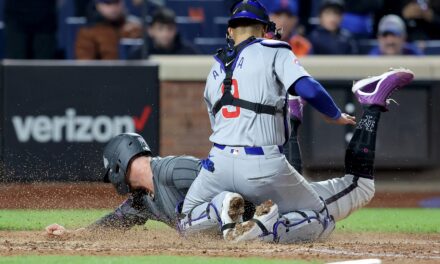
Based upon how great deGrom has pitched this season, it should come as no surprise Jacob deGrom was an All Star this season. After all, he has established himself as the best pitcher in baseball this season. However, if you go all the way back to 2010 draft, this was hardly the prognostication for the then Mets ninth round draft pick.
At the time he was drafted, deGrom was a converted shortstop who was showing some promise as a pitcher. Baseball America‘s draft report of deGrom reflected that assessment:
He threw 89-93 mph on scout day with command, and he had a strong outing going head-to-head with Chris Sale of Florida Gulf Coast. He throws strikes as his arm works well, he’s athletic and has a clean delivery. There were some reports that deGrom, at 6-foot-4, 185 pounds, was hitting 94 mph with his fastball late in the year, and he has a solid if inconsistent slider to go with it. His changeup is in its nascent stages.
After a rough debut in Kingsport, which included a 5.19 ERA and a 1.577 WHIP, it was discovered deGrom had a torn UCL. As a result, he would have Tommy John surgery causing him to miss all of the 2011 season. Naturally, you did not see any major publications touting deGrom as a future Major League pitcher let alone an ace.
In a story that has long been told, deGrom used his rehabilitation time to work on a number of things including his changeup. In fact, Johan Santana would teach him how to throw the changeup, which was something that would have a profound impact on deGrom’s career.
With his improved mechanics and secondary pitches still in their early development stages, deGrom would have a terrific season split between Savannah (the Mets South-Atlantic League affiliate before they moved to Columbia) and St. Lucie. This got him attention with Baseball America updating his outlook as one of ” a potential No. 3 or 4 starter.”
Instead of following a breakout 2012 season with better stats, deGrom would struggle in 2013 posting a 4.51 ERA and 1.449 WHIP across 26 starts mainly split between Double-A Binghamton and Triple-A Las Vegas. Despite the struggles, he did show something with John Sickels of Minor League Ball did foresee deGrom being a “sleepeer prospect” and giving him a C+ grade.
Overall, Sickels noted deGrom “looks like a future number three or four starter to me, with bullpen work a backup option to keep in mind if his breaking ball doesn’t sharpen up.”
Looking back at the scouting reports from before deGrom was called-up to the majors, it is fascinating to see deGrom was viewed as a back of the rotation starter or bullpen arm. At that time, no one even contemplated deGrom as a Top 100 prospect. In fact, deGrom wasn’t even viewed as a Top 10 Mets prospect.
MLB Pipeline not only had deGrom outside their Top 20, they had him ranked behind pitchers like Rafael Montero, Gabriel Ynoa, Cory Mazzoni, Jack Leathersich, and Marcos Molina.
Sickels was relatively bullish on deGrom ranking him 12th among Mets prospects on Minor League Ball. In his rankings, he would have Montero as the only pitcher ahead of deGrom.
Sickels and MLB Pipeline were hardly alone in that assessment. Back then, everyone, including the Mets, had Montero, not deGrom, as joining Matt Harvey and Noah Syndergaard in what was supposed to become a superstar rotation.
Despite the scouting reports, deGrom went out and was named the 2014 National League Rookie of the Year. The following season, we would see him make the leap and even outpitch Clayton Kershaw and Zack Greinke in the postseason.
At this point in his career, deGrom is leading the majors in ERA and ERA+. He also leads all pitchers in WAR and WPA. Really, he’s the best pitcher in baseball if no one saw it coming throughout his minor league career.















